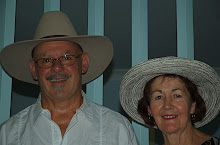In Hamilton, travellers are permitted to stay three days for free but we only stayed for one day. There are toilets on top of this hill, from where I took the photo. By the evening the camp area was packed to capacity.
There is not a tremendous lot in Hamilton, but every town has it's old pub.
The pub still has the remains of the old stables out back.
Tasmania was a penal settlement, that is obvious, from the number of gaols and prisons that are still evident, at least in part. This is all that remains of the Hamilton Prison.
There are many quaint old shops in the small towns.
On our first stop at Bothwell the weather was so inclement that we did not venture out of the van for too long a period, so we decided to come back for a second look while we had a lunch stop. This was the original school building, it is now a golf museum. The town is reputed to have the oldest golf course in Australia.
This was the original school teachers residence. The town provides caravan parking at very reasonable rates, this is located behind the old school and the residence.
One of the old churches in Bothwell.
Must have a photo of the pub.
These old towns still utilise the old original buildings where possible. You notice these barrels all around town in Bothwell, they contain the rubbish bins, great idea there.
This was an early post office building, now a residence. Notice the street sign, it has a tartan pattern background, all of the street signs have a different tartan pattern on them.
Hope you are not tired of old buildings yet, because that's all there is here.
Hand made golf clubs are available in the town with the oldest golf course. I spoke to a person who bought a new driver in this shop and he was happy with the $350 price tag. He said the new club added 50 m to his drive.
Twin cottages from an early time.
Another church and another tartan street sign.
An unusual seat outside the antique shop.
This is a Memorial Avenue of trees along the main road into town, one tree for each resident who lost his life in WW 1.
The town of Oatlands is notable for the working wind driven stone ground flour mill in Australia. The mill has been fully restored after being burnt in bush fires in the 1930's.
The town provides free camping adjacent to the flour mill and beside this lake. Swans, geese and ducks also make residence here.
We took a walk around the lake and this is the view back across the lake to the the free van camp. We liked the town, and the people camped around us, so much, that we stayed the regulation three nights in the camp area. By Saturday night there were about 38 camps crammed into there.
In the past Aboriginals and Bush Rangers have lived in the caves around the lake now Judy is tempted to try them out.
This is a discarded cap piece off the flour mill.
Another grand entrance.
Oatlands Council Offices and the War Memorial.
In the original town some of the footpaths were hewn from the base rock, some are still evident today.
Four original cottages still standing together in the main street of Oatlands. In all of these old towns, the likes of Bothwell, Oatlands, Ross, Campbell Town and Hamilton the modern houses look completely out of place.
The ducks and the geese came around to the van door twice a day looking for a handout, Judy usually obliged. You will notice that one of the ducks has left something in return on our door mat.




























No comments:
Post a Comment